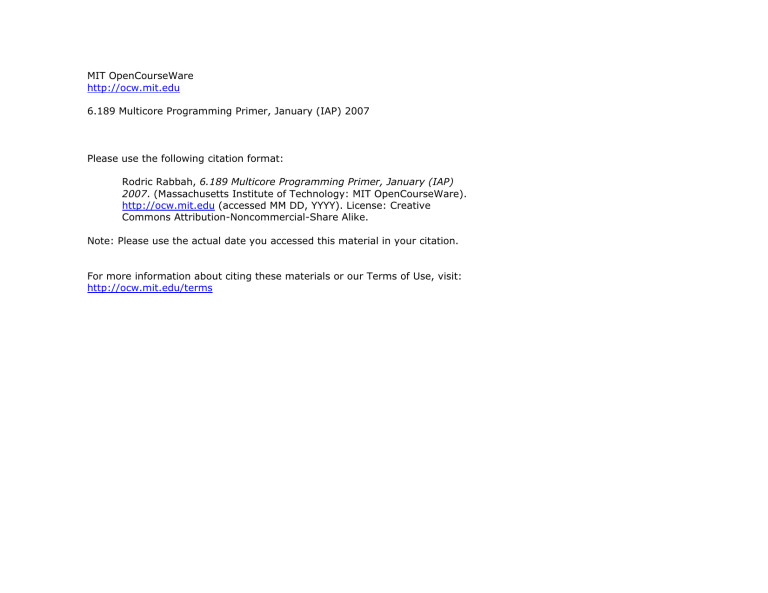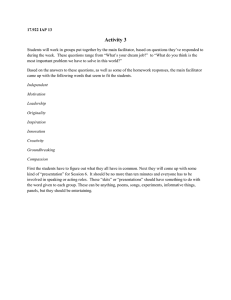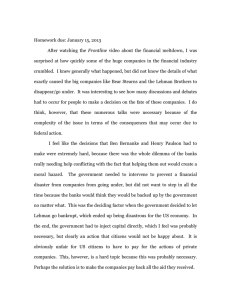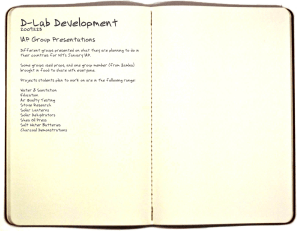MIT OpenCourseWare 6.189 Multicore Programming Primer, January (IAP) 2007

MIT OpenCourseWare http://ocw.mit.edu
6.189 Multicore Programming Primer, January (IAP) 2007
Please use the following citation format:
Rodric Rabbah, 6.189 Multicore Programming Primer, January (IAP)
2007 . (Massachusetts Institute of Technology: MIT OpenCourseWare). http://ocw.mit.edu
(accessed MM DD, YYYY). License: Creative
Commons Attribution-Noncommercial-Share Alike.
Note: Please use the actual date you accessed this material in your citation.
For more information about citing these materials or our Terms of Use, visit: http://ocw.mit.edu/terms
6.189 IAP 2007
Lecture7
Design Patterns for
Parallel Programming II
Dr. Rodric Rabbah © Copyrights by IBM Corp. and by other(s) 2007 1 6.189 IAP 2007 MIT
Recap: Common Steps to Parallelization
Partitioning
Sequential computation m p o s d e c o i t i o n
Tasks a s s i g n m e n t p
0 p
1 p
2 p
3 e s t r o r c h a t i o n
Execution
Units p
0 p
1 p
2 p
3 i n g m a p p
P
0
P
2
P
1
P
3
Parallel
Program
Processors
Dr. Rodric Rabbah © Copyrights by IBM Corp. and by other(s) 2007 2 6.189 IAP 2007 MIT
Recap: Decomposing for Concurrency
MPEG Decoder frequency encoded macroblocks
ZigZag
IQuantization
IDCT
Saturation spatially encoded macroblocks
MPEG bit stream
VLD macroblocks, motion vectors split differentially coded motion vectors
Motion Vector Decode
Repeat motion vectors join
●
●
Task decomposition
Parallelism in the application
Data decomposition
Same computation many data
Motion
Compensation recovered picture
Picture Reorder
Color Conversion
Display
Dr. Rodric Rabbah © Copyrights by IBM Corp. and by other(s) 2007
● Pipeline decomposition
Data assembly lines
Producer-consumer chains
3 6.189 IAP 2007 MIT
Dependence Analysis
● Given two tasks how to determine if they can safely run in parallel?
Dr. Rodric Rabbah © Copyrights by IBM Corp. and by other(s) 2007 4 6.189 IAP 2007 MIT
Bernstein’s Condition
●
R i
: set of memory locations read (input) by task
T i
●
W j
: set of memory locations written (output) by task
T j
● Two tasks
T
1 and
T
2 are parallel if input to
T
1 is not part of output from
T
2
input to
T
2 is not part of output from
T
1
outputs from
T
1 and
T
2 do not overlap
Dr. Rodric Rabbah © Copyrights by IBM Corp. and by other(s) 2007 5 6.189 IAP 2007 MIT
Example
T
1 a = x + y
T
2 b = x + z
R
1
W
1
= { x, y }
= { a }
R
1
I W
2
W
1
I W
2
=
R
2
I W
1
=
=
φ
φ
φ
Dr. Rodric Rabbah © Copyrights by IBM Corp. and by other(s) 2007 6
R
2
W
2
= { x, z }
= { b }
6.189 IAP 2007 MIT
Patterns for Parallelizing Programs
4 Design Spaces
Algorithm Expression
● Finding Concurrency
Expose concurrent tasks
● Algorithm Structure
Map tasks to units of execution to exploit parallel architecture
Software Construction
● Supporting Structures
Code and data structuring patterns
● Implementation Mechanisms
Low level mechanisms used to write parallel programs
Dr. Rodric Rabbah © Copyrights by IBM Corp. and by other(s) 2007 7
Patterns for Parallel
Programming. Mattson,
Sanders, and Massingill
(2005).
6.189 IAP 2007 MIT
Algorithm Structure Design Space
● Given a collection of concurrent tasks, what’s the next step?
● Map tasks to units of execution (e.g., threads)
● Important considerations
Magnitude of number of execution units platform will support
Cost of sharing information among execution units
Avoid tendency to over constrain the implementation
–
Work well on the intended platform
–
Flexible enough to easily adapt to different architectures
Dr. Rodric Rabbah © Copyrights by IBM Corp. and by other(s) 2007 8 6.189 IAP 2007 MIT
Major Organizing Principle
● How to determine the algorithm structure that represents the mapping of tasks to units of execution?
● Concurrency usually implies major organizing principle
Organize by tasks
Organize by data decomposition
Organize by flow of data
Dr. Rodric Rabbah © Copyrights by IBM Corp. and by other(s) 2007 9 6.189 IAP 2007 MIT
Organize by Tasks?
Recursive? no
Task
Parallelism yes
Divide and Conquer
Dr. Rodric Rabbah © Copyrights by IBM Corp. and by other(s) 2007 1 0 6.189 IAP 2007 MIT
Task Parallelism
● Ray tracing
Computation for each ray is a separate and independent
● Molecular dynamics
Non-bonded force calculations, some dependencies
● Common factors
Tasks are associated with iterations of a loop
Tasks largely known at the start of the computation
All tasks may not need to complete to arrive at a solution
Dr. Rodric Rabbah © Copyrights by IBM Corp. and by other(s) 2007 11 6.189 IAP 2007 MIT
Divide and Conquer
● For recursive programs: divide and conquer
Subproblems may not be uniform
May require dynamic load balancing compute subproblem split subproblem compute subproblem problem split join subproblem compute subproblem split join compute subproblem subproblem subproblem join solution
Dr. Rodric Rabbah © Copyrights by IBM Corp. and by other(s) 2007 12 6.189 IAP 2007 MIT
Organize by Data?
● Operations on a central data structure
Arrays and linear data structures
Recursive data structures
Recursive? no
Geometric
Decomposition yes
Recursive Data
Dr. Rodric Rabbah © Copyrights by IBM Corp. and by other(s) 2007 13 6.189 IAP 2007 MIT
Geometric Decomposition
● Gravitational body simulator
Calculate force between pairs of objects and update accelerations
VEC3D acc[NUM_BODIES] = 0; for (i = 0; i < NUM_BODIES - 1; i++) { for (j = i + 1; j < NUM_BODIES; j++) {
// Displacement vector
VEC3D d = pos[j] – pos[i];
// Force t = 1 / sqr(length(d));
// Components of force along displacement d = t * (d / length(d));
}
} acc[i] += d * mass[j]; acc[j] += -d * mass[i]; pos
Dr. Rodric Rabbah © Copyrights by IBM Corp. and by other(s) 2007 pos vel
14 6.189 IAP 2007 MIT
Recursive Data
● Computation on a list, tree, or graph
Often appears the only way to solve a problem is to sequentially move through the data structure
● There are however opportunities to reshape the operations in a way that exposes concurrency
Dr. Rodric Rabbah © Copyrights by IBM Corp. and by other(s) 2007 15 6.189 IAP 2007 MIT
Recursive Data Example: Find the Root
● Given a forest of rooted directed trees, for each node, find the root of the tree containing the node
Parallel approach: for each node, find its successor’s successor, repeat until no changes
–
O(log n) vs. O(n)
4
3
2
1 6
5 7
Step 1
4
3
2
1 6
5 7
Step 2
4
3
2
1 6
5 7
Step 3
Dr. Rodric Rabbah © Copyrights by IBM Corp. and by other(s) 2007 16 6.189 IAP 2007 MIT
Work vs. Concurrency Tradeoff
● Parallel restructuring of find the root algorithm leads to O(n log n) work vs. O(n) with sequential approach
● Most strategies based on this pattern similarly trade off increase in total work for decrease in execution time due to concurrency
Dr. Rodric Rabbah © Copyrights by IBM Corp. and by other(s) 2007 17 6.189 IAP 2007 MIT
Organize by Flow of Data?
● In some application domains, the flow of data imposes ordering on the tasks
Regular, one-way, mostly stable data flow
Irregular, dynamic, or unpredictable data flow yes
Regular? Pipeline no
Event-based
Coordination
Dr. Rodric Rabbah © Copyrights by IBM Corp. and by other(s) 2007 18 6.189 IAP 2007 MIT
Pipeline Throughput vs. Latency
● Amount of concurrency in a pipeline is limited by the number of stages
● Works best if the time to fill and drain the pipeline is small compared to overall running time
● Performance metric is usually the throughput
Rate at which data appear at the end of the pipeline per time unit (e.g., frames per second)
● Pipeline latency is important for real-time applications
Time interval from data input to pipeline, to data output
Dr. Rodric Rabbah © Copyrights by IBM Corp. and by other(s) 2007 1 9 6.189 IAP 2007 MIT
Event-Based Coordination
● In this pattern, interaction of tasks to process data can vary over unpredictable intervals
● Deadlocks are likely for applications that use this pattern
Dr. Rodric Rabbah © Copyrights by IBM Corp. and by other(s) 2007 20 6.189 IAP 2007 MIT
6.189 IAP 2007
Supporting Structures
SPMD
Loop parallelism
Master/Worker
Fork/Join
Dr. Rodric Rabbah © Copyrights by IBM Corp. and by other(s) 2007 21 6.189 IAP 2007 MIT
SPMD Pattern
● Single Program Multiple Data: create a single source-code image that runs on each processor
Initialize
Obtain a unique identifier
Run the same program each processor
–
Identifier and input data differentiate behavior
Distribute data
Finalize
Dr. Rodric Rabbah © Copyrights by IBM Corp. and by other(s) 2007 22 6.189 IAP 2007 MIT
Example: Parallel Numerical Integration
4.0
2.0 f(x) =
4.0
(1+x 2 )
0.0 X 1.0 static long num_steps = 100000; void main()
{ int i; double pi, x, step, sum = 0.0; step = 1.0 / (double) num_steps; for (i = 0; i < num_steps; i++){ x = (i + 0.5)
∗ step; sum = sum + 4.0 / (1.0 + x
∗ x);
} pi = step
∗ sum; printf(“Pi = %f\n”, pi);
Dr. Rodric Rabbah © Copyrights by IBM Corp. and by other(s) 2007 23 6.189 IAP 2007 MIT
Computing Pi With Integration (MPI)
static long num_steps = 100000; void main(int argc, char* argv[])
{ int i_start, i_end, i, myid, numprocs; double pi, mypi, x, step, sum = 0.0;
MPI_Init(&argc, &argv);
MPI_Comm_size(MPI_COMM_WORLD, &numprocs);
MPI_Comm_rank(MPI_COMM_WORLD, &myid);
MPI_BCAST(&num_steps, 1, MPI_INT, 0, MPI_COMM_WORL
D); i_start = my_id
∗
(num_steps/numprocs) i_end = i_start + (num_steps/numprocs) step = 1.0 / (double) num_steps; for (i = i_start; i < i_end; i++) { x = (i + 0.5)
∗ step sum = sum + 4.0 / (1.0 + x
∗ x);
} mypi = step * sum;
MPI_REDUCE(&mypi, &pi, 1, MPI_DOUBLE, MPI_SUM, 0, MPI_COMM_WORLD); if (myid == 0) printf( “ Pi = %f\n ” , pi);
MPI_Finalize();
}
Dr. Rodric Rabbah © Copyrights by IBM Corp. and by other(s) 2007 24 6.189 IAP 2007 MIT
Block vs. Cyclic Work Distribution
static long num_steps = 100000; void main(int argc, char* argv[])
{ int i_start, i_end, i, myid, numprocs; double pi, mypi, x, step, sum = 0.0;
MPI_Init(&argc, &argv);
MPI_Comm_size(MPI_COMM_WORLD, &numprocs);
MPI_Comm_rank(MPI_COMM_WORLD, &myid);
MPI_BCAST(&num_steps, 1, MPI_INT, 0, MPI_COMM_WORLD); i_start = my_id
∗
(num_steps/numprocs) i_end = i_start + (num_steps/numprocs) step = 1.0 / (double) num_steps; for (i = myid; i < num_steps; i += numprocs) { x = (i + 0.5)
∗ step sum = sum + 4.0 / (1.0 + x
∗ x);
} mypi = step * sum;
MPI_REDUCE(&mypi, &pi, 1, MPI_DOUBLE, MPI_SUM, 0, MPI_COMM_WORLD); if (myid == 0) printf( “ Pi = %f\n ” , pi);
MPI_Finalize();
}
Dr. Rodric Rabbah © Copyrights by IBM Corp. and by other(s) 2007 25 6.189 IAP 2007 MIT
SPMD Challenges
● Split data correctly
● Correctly combine the results
● Achieve an even distribution of the work
● For programs that need dynamic load balancing, an alternative pattern is more suitable
Dr. Rodric Rabbah © Copyrights by IBM Corp. and by other(s) 2007 26 6.189 IAP 2007 MIT
Loop Parallelism Pattern
● Many programs are expressed using iterative constructs
Programming models like OpenMP provide directives to automatically assign loop iteration to execution units
Especially good when code cannot be massively restructured
#pragma omp parallel for for(i = 0; i < 12; i++)
C[i] = A[i] + B[i]; i = 0 i = 1 i = 2 i = 3 i = 4 i = 5 i = 6 i = 7 i = 8 i = 9 i = 10 i = 11
Dr. Rodric Rabbah © Copyrights by IBM Corp. and by other(s) 2007
27 6.189 IAP 2007 MIT
Master/Worker Pattern
master A
B
C
D
E
Independent Tasks
A
B
C
E worker worker
Dr. Rodric Rabbah © Copyrights by IBM Corp. and by other(s) 2007 28 worker
D worker
6.189 IAP 2007 MIT
Master/Worker Pattern
● Particularly relevant for problems using task parallelism pattern where task have no dependencies
Embarrassingly parallel problems
● Main challenge in determining when the entire problem is complete
Dr. Rodric Rabbah © Copyrights by IBM Corp. and by other(s) 2007 29 6.189 IAP 2007 MIT
Fork/Join Pattern
● Tasks are created dynamically
Tasks can create more tasks
● Manages tasks according to their relationship
● Parent task creates new tasks (fork) then waits until they complete (join) before continuing on with the computation
Dr. Rodric Rabbah © Copyrights by IBM Corp. and by other(s) 2007 30 6.189 IAP 2007 MIT
6.189 IAP 2007
Communication Patterns
Point-to-point
Broadcast
Reduction
Dr. Rodric Rabbah © Copyrights by IBM Corp. and by other(s) 2007 31 6.189 IAP 2007 MIT
Serial Reduction
A[0] A[1] A[2] A[3]
A[0:1]
A[0:2]
A[0:3]
● When reduction operator is not associative
● Usually followed by a broadcast of result
Dr. Rodric Rabbah © Copyrights by IBM Corp. and by other(s) 2007 32 6.189 IAP 2007 MIT
Tree-based Reduction
A[0] A[1] A[2] A[3]
A[2:3] A[0:1]
A[0:3]
● n steps for 2 n units of execution
● When reduction operator is associative
● Especially attractive when only one task needs result
Dr. Rodric Rabbah © Copyrights by IBM Corp. and by other(s) 2007 33 6.189 IAP 2007 MIT
Recursive-doubling Reduction
A[0] A[1] A[2] A[3]
A[0:1] A[0:1] A[2:3] A[2:3]
A[0:3] A[0:3] A[0:3] A[0:3]
● n steps for 2 n units of execution
● If all units of execution need the result of the reduction
Dr. Rodric Rabbah © Copyrights by IBM Corp. and by other(s) 2007 34 6.189 IAP 2007 MIT
Recursive-doubling Reduction
● Better than tree-based approach with broadcast
Each units of execution has a copy of the reduced valut at the end of n steps
In tree-based approach with broadcast
–
–
–
–
Reduction takes n steps
Broadcast cannot begin until reduction is complete
Broadcast takes n steps (architecture dependent)
O(n) vs. O(2n)
Dr. Rodric Rabbah © Copyrights by IBM Corp. and by other(s) 2007 35 6.189 IAP 2007 MIT
6.189 IAP 2007
Summary
Dr. Rodric Rabbah © Copyrights by IBM Corp. and by other(s) 2007 3 6 6.189 IAP 2007 MIT
Algorithm Structure and Organization
SPMD
Loop
Parallelism
Master/
Worker
Task parallelism
Divide and conquer
Geometric decomposition
Recursive data
Pipeline Event-based coordination
**** *** **** ** *** **
**** ** ***
**** ** * * **** *
Fork/
Join
** **** ** **** ****
● Patterns can be hierarchically composed so that a program uses more than one pattern
6.189 IAP 2007 MIT Dr. Rodric Rabbah © Copyrights by IBM Corp. and by other(s) 2007 37



